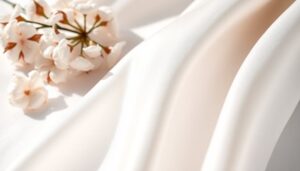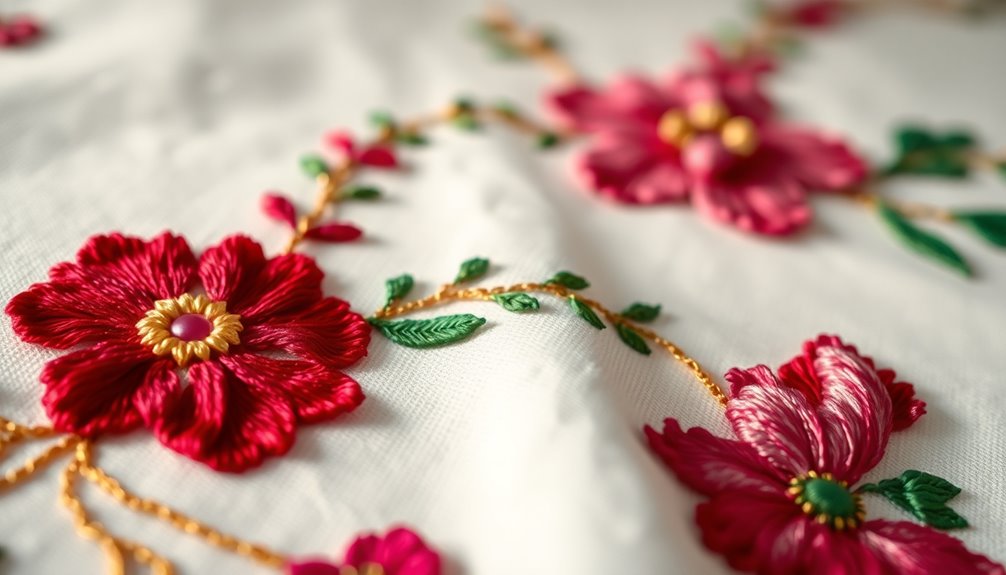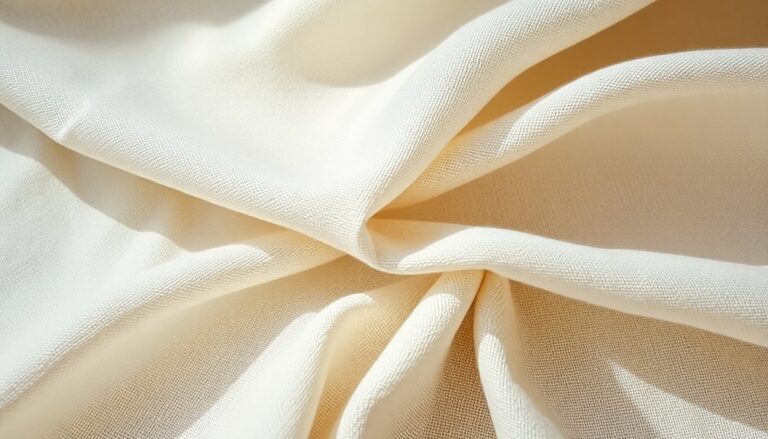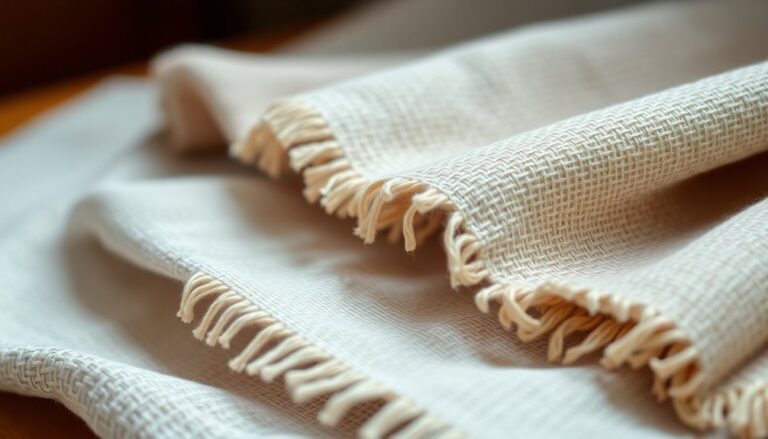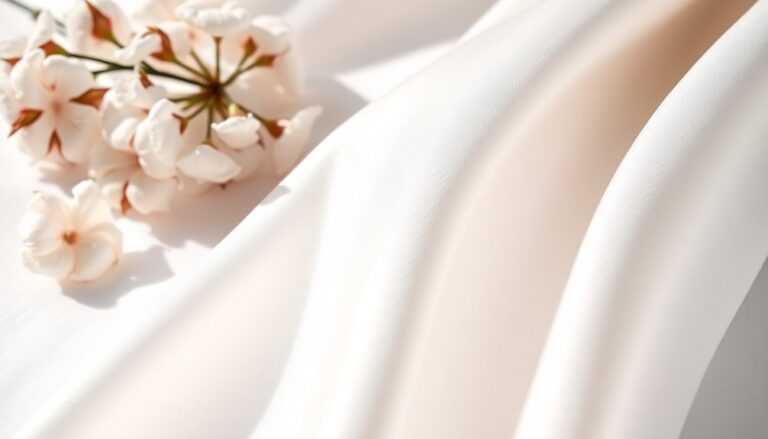Embroidery on linens requires careful attention to fabric, thread, and tools for achieving beautiful results. Choosing the right linen weight impacts the design's appearance. Various types of threads, from delicate to bold, influence the final look. Crucial tools like sharp needles and embroidery hoops streamline the process. Beginners can start with basic stitches, as advanced techniques can enhance their work. Proper care and maintenance can guarantee longevity. With these guidelines, one can access the joys of linen embroidery.
Article Highlights
- Select the appropriate linen weight based on the intricacy of your design for optimal results in embroidery.
- Choose high-quality threads like cotton or rayon to enhance the durability and appearance of your embroidery.
- Utilize essential tools such as sharp needles and embroidery hoops to streamline your creative process and improve stitching quality.
- Experiment with basic and advanced stitching techniques to build your skills and elevate the overall look of your embroidered linens.
- Follow proper care instructions, including gentle washing and air-drying, to maintain the quality and longevity of your embroidered pieces.
Choosing the Right Linen for Embroidery
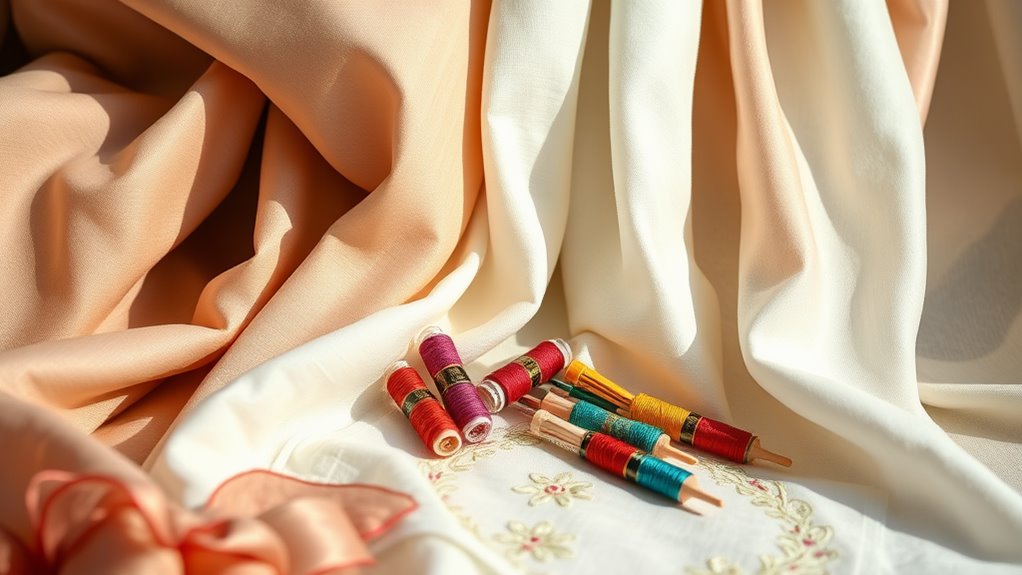
In relation to selecting the right linen for embroidery, there are a few key factors to take into account. One vital aspect is linen weight, which impacts the overall look and feel of the finished piece. Heavier linen provides a sturdy base for intricate designs, while lighter linen is ideal for delicate patterns. Furthermore, comprehending different fabric types is fundamental; pure linen offers an elegant finish, whereas linen blends can improve durability and ease of care. Each fabric type behaves differently under the needle, affecting thread tension and stitch definition. Consequently, choosing the appropriate linen weight and fabric type can greatly influence the success of an embroidery project, ensuring that the final result meets the creator's expectations.
Selecting Threads and Other Materials
When it relates to embroidery, the choice of threads and materials plays an essential role in achieving the desired outcome. There are various thread types available, each offering distinct qualities that can improve a project's overall appearance. Moreover, selecting high-quality fabric guarantees that the embroidery stands out and lasts over time.
Thread Types Overview
Choosing the right thread for embroidery on linens is crucial, as it can greatly affect the final appearance and durability of the design. There's a wide variety of threads available, each suited for different effects. A thread weight comparison helps embroiderers select the ideal thickness for their projects; thinner threads provide delicate details, whereas thicker threads offer bold statements. Furthermore, thread color variations allow for creative expression, enabling artists to match or contrast with the linen's hue. Cotton, polyester, and rayon are popular choices, each offering unique qualities. Cotton is durable and matte, whereas polyester shines and resists fading. By comprehending these factors, embroiderers can improve their designs considerably, ensuring a beautiful and lasting finish.
Choosing Fabric Quality
In the process of selecting high-quality fabric is essential for successful embroidery, it's equally important to contemplate the threads and materials that will complement the chosen linen. A good fabric should not just provide aesthetic appeal but also guarantee fabric durability, standing up to both wear and washing. When choosing threads, one must consider their weight and sheen, as these factors can greatly impact the overall design. Furthermore, a texture comparison between different linens and threads can reveal how they interact; for instance, a rougher fabric might require smoother threads to prevent snagging. In the end, thoughtful selection of both fabric and materials leads to beautiful, lasting embroidery that showcases the art of craftsmanship.
Essential Tools for Linen Embroidery
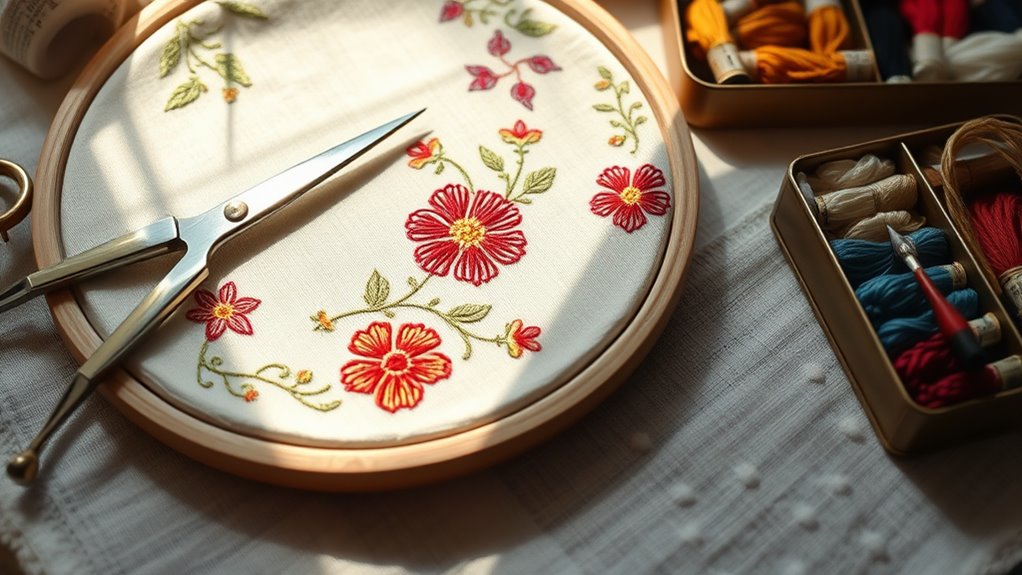
In regard to linen embroidery, having the right tools can make all the difference. From must-have supplies to choosing the perfect threads, beginners should focus on crucial items that improve their craft. Comprehending these tools not merely simplifies the process but furthermore raises the quality of the finished work.
Must-Have Embroidery Supplies
Every embroiderer needs a solid set of supplies to bring their linen projects to life. Vital tools like high-quality needles, sharp scissors, and embroidery hoops are critical for achieving precise results. Furthermore, a reliable embroidery storage solution can help organize threads, patterns, and tools, making it easier to tackle seasonal embroidery projects. These supplies not just streamline the creative process but also guarantee that everything's within reach when inspiration strikes. A well-stocked workspace encourages experimentation, allowing embroiderers to explore diverse techniques and styles. With the right supplies, they can enhance their linen embroidery, creating beautiful, lasting pieces that reflect their unique flair. Investing in these must-have tools is a step toward embroidery success.
Choosing the Right Threads
How do you choose the right threads for linen embroidery? Selecting the appropriate threads is essential for a successful project. Comprehending color theory helps in choosing shades that complement each other, guaranteeing the design pops. Furthermore, thread durability plays an important role, as some threads withstand wear and washing better than others.
When considering threads, keep these key points in mind:
- Material: Cotton and silk are popular options for their sheen and softness.
- Thickness: Choose thread weight based on the linen's weave to avoid puckering.
- Colorfastness: Verify the colors won't bleed or fade over time.
Essential Tools for Beginners
Embroidery on linen requires a few vital tools that can make all the difference for beginners. First, an embroidery kit is fundamental, as it typically includes needles, threads, and hoops customized for various projects. Beginners should likewise invest in quality embroidery scissors, which help achieve clean cuts and prevent fraying. A good fabric marker or chalk is helpful for transferring patterns accurately. Furthermore, having a needle threader can save time and reduce frustration, especially when dealing with finer threads. Finally, beginners should keep in mind common beginner mistakes, like not using a hoop or choosing the wrong needle, which can hinder progress. With the right tools, beginners can enjoy their embroidery experience with confidence.
Basic Embroidery Techniques for Beginners
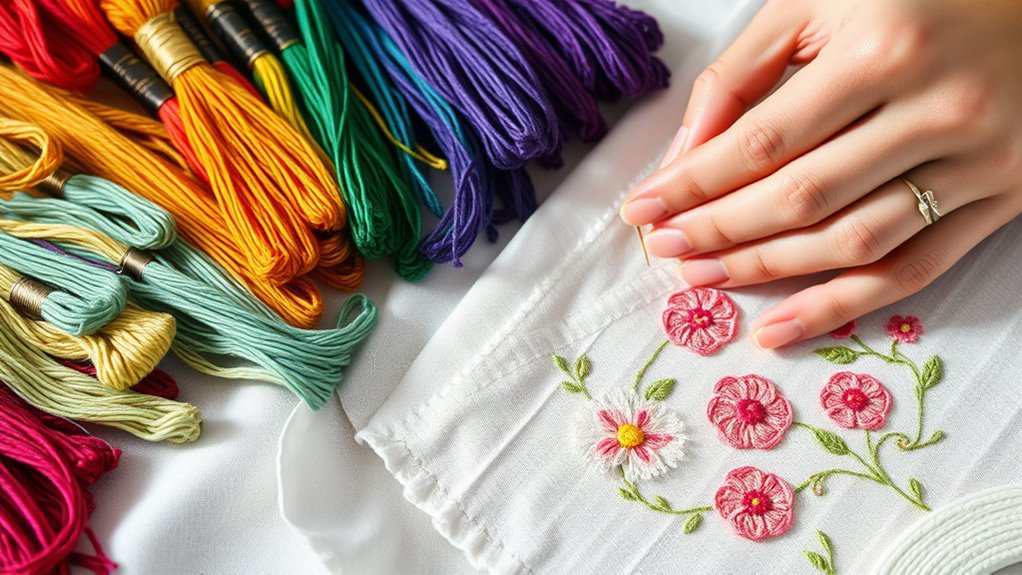
Starting out in the domain of embroidery can feel like stepping into a colorful fabric of creativity. For beginners, perfecting basic stitch techniques is key to building confidence and skill. Simple stitches can create beautiful designs, making them perfect for initial projects.
Here are three beginner project ideas:
- Decorative Handkerchiefs: Use basic stitches to add personal touches.
- Embroidered Pillow Covers: Experiment with different colors and patterns.
- Simple Tote Bags: Showcase your creativity as you make a practical item.
Advanced Stitching Techniques to Enhance Your Work
While perfecting basic stitches lays a solid foundation, incorporating advanced stitching techniques can truly improve one's embroidery projects. Techniques like the French knot and satin stitch add depth and texture, elevating the overall appearance of the work. The French knot, with its playful, raised texture, is perfect for creating intricate floral designs or adding detail to any motif. It's a simple yet effective way to bring life to the piece. Conversely, the satin stitch offers a smooth, polished finish that fills shapes beautifully. By mastering these techniques, embroiderers can transform their linens into stunning pieces of art, showcasing both skill and creativity. Embracing these advanced stitches will certainly take one's embroidery to the next level.
Designing Your Embroidery Patterns
When creating embroidery patterns, the design process can be both exciting and challenging. It requires a balance between creativity and technique. To start, one can draw from various sources for pattern inspiration, ensuring a unique touch. Here are some ideas to contemplate:
- Nature: Flowers, leaves, and scenery can provide beautiful motifs.
- Cultural motifs: Traditional designs from different cultures can add depth and meaning.
- Abstract shapes: Experimenting with geometric patterns can lead to modern aesthetics.
Additionally, selecting harmonious color combinations can greatly impact the overall feel of the design. It is crucial to choose colors that complement each other as you reflect the intended theme. By keeping these elements in mind, anyone can create stunning embroidery patterns that stand out beautifully on linens.
Caring for Your Embroidered Linens
After crafting beautiful embroidery patterns, taking proper care of those embroidered linens guarantees they remain lively and intact for years to come. It's crucial to follow specific washing instructions to preserve the delicate threads and fabrics. Always wash embroidered linens in cold water on a gentle cycle, using mild detergent. Avoid bleach and harsh chemicals that can harm the embroidery. When drying, air-drying is preferable to prevent shrinkage and fading.
Storing linens properly is equally important. They should be kept in a cool, dry place, away from direct sunlight to prevent discoloration. Folding them neatly and using acid-free tissue paper can help maintain their shape and prevent creasing. With these simple steps, embroidered linens can be enjoyed for generations.
Frequently Asked Questions
Can I Use Machine Embroidery on Linen?
When considering machine embroidery on linen, it's essential to recognize that most machine types can handle this fabric well. Nevertheless, care should be taken in selecting the appropriate needle and stabilizer to prevent puckering. Moreover, linen care should be prioritized, as it's a delicate fabric that may shrink with improper washing. With the right techniques, machine embroidery can create stunning designs on linen, making it a popular choice for various projects.
How Do I Fix Mistakes in My Embroidery?
In terms of refining one's embroidery, embracing the art of mistake correction can be a true game-changer. She knows that unraveling a few stitches or redoing a section can feel intimidating, but it's all part of the process. Using various embroidery techniques, like careful snipping or adding embellishments, can turn those little hiccups into delightful surprises. With patience and creativity, every stitch can become a reflection of growth and artistry.
What Are Common Embroidery Stitches for Beginners?
When exploring common embroidery stitches for beginners, one should focus on basic stitch techniques. These include the backstitch, running stitch, and satin stitch, which are simple yet effective. Furthermore, having vital tools like embroidery floss, needles, and fabric is important for success. With practice, beginners can master these stitches, allowing them to create beautiful designs. It's all about starting with the fundamentals and gradually building skills over time.
How Do I Transfer Designs Onto Linen?
To transfer designs onto linen, one can explore various design transfer methods. Tracing paper techniques are particularly effective; the individual can place tracing paper over the design, then trace it with a pencil. After that, they can secure the tracing paper onto the linen and carefully trace again, transferring the design. On the other hand, carbon paper can be used for a more direct method. Each technique offers a simple way to achieve accurate design placement.
Is It Safe to Wash Embroidered Linens?
When it relates to washing embroidered linens, it's important to follow proper fabric care to guarantee their longevity. Using gentle washing techniques, like cold water and mild detergent, can help maintain the integrity of both the fabric and the embroidery. Avoiding harsh chemicals and high heat is vital, as they can damage delicate stitches. By taking these precautions, one can safely enjoy the beauty of their embroidered linens for years to come.

